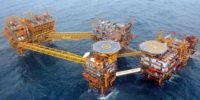As was speculated, the Biden Administration has approved the record of decision to enable construction of the estimated $8-billion Willow oil project on Alaska’s North Slope, in the National Petroleum Reserve on federal land, which developer ConocoPhillips has said could produce more than 180,000 barrels of oil per day.
But in response to strong pushback from environmental and local opponents, the U.S. Interior Dept. also proposed on March 12 to bar oil drilling in 3 million Arctic Ocean acres in the reserve and limit energy development on 13 million land acres, with specifics to be outlined in new rulemaking now being launched.
Willow's final approval by the U.S. Interior Dept. mirrors an augmented agency environmental review published last month under court order that approves three drilling sites in the area, the minimum ConocoPhillips says makes the project economically feasible. Energy analyst Wood Mackenzie said its modeling "supports that claim."
In its final approval, Interior opted to reject a fourth site that it previously said it would defer for later consideration. ConocoPhillips also must give up 68,000 acres under existing leases that date to the 1990s.
The research firm says ConocoPhillips is set to use a specially-built drill rig, the largest mobile land rig in North America, which can drill wells that are more than 40,000 ft long. "The wells will be longer and bigger. That means production and reserves are not really affected, even though the above-ground impact is reduced, says Wood Mackenzie Vice Chairman Ed Crooks. "The company is well-practiced in drilling very long wells."
The energy firm, which had originally sought approval for up to five drill sites, a central processing plant, 37 miles of gravel roads, up to 700 miles of ice roads, 390 miles of pipelines and two airstrips, estimates there are 450 to 800 million barrels of recoverable oil in the Willow project area.
Construction would take eight to 10 years, but oil would begin to be pumped in year six or seven, possibly by 2029, but it is not clear if development will proceed on that timeline
The scaled-back Willow approval is estimated to reduce the project footprint by about one-third but the three locations will still allow for nearly 200 wells to be drilled, capable of producing oil for up to three decades, says Interior.
In the record of decision, Interior said a Willow project redesign underway would have “the fewest ice roads, fewest total miles of infield pipelines, least water use, fewest vehicle trips, fewest fixed-wing aircraft trips, fewest helicopter trips, and fewest acres of screeding.”
It also cuts the number of site facilities and activities and limits water and gravel use to “reduce impacts" to surface resources used by native Alaska residents, said Interior, also noting the development approach has the least total greenhouse gas emissions.
“The actions will create an additional buffer from exploration and development activities near the calving grounds and migratory routes for the Teshekpuk Lake caribou herd, an important subsistence resource for nearby Alaska Native communities,” Interior said. “They significantly scale back the Willow Project within the constraints of valid existing rights under decades-old leases issued by prior Administrations.”
But climate activists have rallied against the project, calling it a “carbon bomb” that would not support President Joe Biden’s campaign pledges to curb new oil and gas drilling.
Pausing on Construction
Six Alaskan and national project opponent groups said March 14 that they had jointly filed a lawsuit in Anchorage federal district court against Interior and other agencies, claiming the Willow approval violates multiple federal law. They also seek a preliminary injunction on construction activities, citing "irreparable harm" to wildlife from startup activity. The Center for Biological Diversity has filed a separate suit.
Interior, represented by the US Justice Dept., has asked Judge Sharon Gleason for an injunction ruling between March 28 and April 3, noting that the region's winter construction season for energy projects ends April 25, after which melting ice and snow "would compromise or prevent the viability" of activity.
ConocoPhillips, the Alaska legislature and some native Alaskan group supporters have filed briefs in support of Interior.
The energy firm said in a court filing that it has begun building the ice road for the project but would delay work in gravel mining and roadbuilding until April 4 while the court reviews the injunction request. Its "concession on this schedule is not an admission that any of the planned activities causes irreparable harm,” the Justice filing adds.
The firm will maintain a 40-person construction workforce, according to the Anchorage Daily News.
ConocoPhillips in a statement related to the approval said it “welcomes” the three-pad approval and is moving its internal project approval process toward a final investment decision. The firm did not specify or estimate a date for that.
“Willow fits within the Biden Administration’s priorities on environmental and social justice, facilitating the energy transition and enhancing our energy security, all while creating good union jobs and providing benefits to Alaska Native communities,” said Ryan Lance, ConocoPhillips chairman and CEO.
A ConocoPhillips spokesman told ENR that 75% of total North Slope installation workhours will be union. It has said it expects 2,500 construction jobs. He said the firm has spent about $600 million "pursuing the project" to date.
The spokesman declined to release names of engineers and contractors that have worked on project setup activities such as lease acquisition, seismic and exploration analysis, appraisal drilling and development engineering .
Pros and Cons
In a joint statement, U.S. Senators Lisa Murkowski and Dan Sullivan (both R-Alaska) and Rep. Mary Peltola (D-Alaska) noted the federal approval of an "economically viable" project “after litigation, a court remand, years of supplemental environmental analysis, and a united statewide push in strong support.”
Alaska lawmakers, unions and some communities have pressured the Administration to approve the project, saying it would bring the state much-needed jobs and billions of dollars in taxes and mitigation funds.
In a March 8 appearance at the major energy sector CERAWeek by S&P Global conference in Houston, Sullivan termed an administration denial of approval for Willow “the second wave of colonialism,” calling it “one of the biggest, most important resource development projects in our state’s history” that he claimed was favored by “the vast majority” of Alaska's native population.
In comments also at that event, Energy Secretary Jennifer Granholm noted that "enormous energy challenges that remain will take partnerships between governments and the private sector to meet," particularly in "growing the energy pie."
While she said that global investment in clean energy matched that of fossil fuel for the first time in 2022, the latter "will remain part of the energy pie for years. We need both traditional and new energy." But she emphasized the need to "advance technology for abating emissions."
Wood Mackenzie forecasts US crude oil production to average about 13.3 bilion barrels per day by first quarter 2024, up from 10.8 billion in Q1 2021.
"A revival of North Slope production is now on," said Mark Oberstoetter, a head analyst for Wood Mackenzie, noting that with other reserve-area projects launched, "we see production returning to 700,000 barrels per day by 2030, levels last seen in 2008." He said without the announced new production, the Trans Alaska Pipeline System "would eventually run into low flow issues, jeopardizing all production coming from the North Slope.”
Wood Mackenzie projected that Willow’s Scope 1 and 2 emissions "would be lower than other Alaska projects, and lower than many of the current sources of US oil imports." Its Scope 3 emissions, generated by burning and use of products derived from crude oil—would be the largest source of emissions, but akin to those of other US projects.
In a statement, Laborers' union President Terry O’Sullivan said Willow project plans include a workforce that is "trained for the exacting, detailed work needed to ensure compliance with Willow’s strict environmental protection requirement."
Nagruk Harcharek, president of the Voice of the Arctic Iñupiat, an Alaska Native organization that supports the project, said in a statement he had been optimistic the administration would "heed strong support for Willow across our state, instead of bowing to the will of outside groups with no ties to our land, heritage or people.”
Athan Manuel, director of the Sierra Club’s lands protection program, said Willow production impact would counteract benefits of the new reserve protections, with the project described as the largest new oil field in Alaska. in decades. “No proposal poses a bigger threat to lands, wildlife, communities and our climate,” she said.
Interior had voiced concern about the project in its latest environmental review, "including direct and indirect greenhouse gas emissions and impacts to wildlife and Alaska Native subsistence,” it said in a statement at the time. The agency said the proposed project would release 284,405 metric tons of gross carbon dioxide emissions for 30 years, with an annual average of 9,480 metric tons of CO2 a year or about 0.145% of the 2019 U.S. greenhouse gas inventory.
The International Energy Agency and other international groups have said developing new oil and gas fields would be incompatible with staying below the 1.5°C threshold of global warming, beyond which climate impacts are forecast to be increasingly severe.
In 2015, President Barack Obama halted most exploration in coastal Arctic Ocean areas, which President Donald Trump reversed, until that move was revoked in 2021 by a U.S. district court judge who also ordered added federal environmental study of the project.






Post a comment to this article
Report Abusive Comment